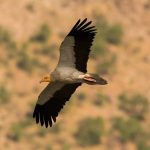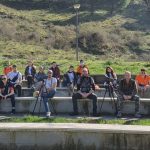The activity
On July 23 and 24, 2020, for the second consecutive year, AOS organized and conducted the monitoring of power lines in the Drinos Valley. This time joined by twelve members from the Conservation Youth Club of Gjirokastra (CYC) and their professor, Dr. Gentian Hyka, under the guidance of four of our experts.
This was their first outdoor activity since the group’s consolidation and a one-of-a-kind opportunity, as they are the first youth conservation network in Albania that actively participates in a completely new dimension of wildlife protection, namely the monitoring of power line infrastructure.
The members of CYC, divided into two groups and equipped with the necessary supplies (shirts, binoculars, telescopes, hats, bags, bird identification guide etc.), were able to monitor approximately 10 km of power lines, split into short sections designated to each group.
During the field survey, we were able to observe various species of birds that use the wires and pylons mainly as perches. Such species include, but are not limited to, the Lesser Kestrel (Falco naumanni) and members of the Corvidae family. It’s also worth mentioning that the valley serves as a nesting ground for the Egyptian Vulture (Neophron percnopterus), which is an endangered species.
The introduction of electric power distribution systems in such natural areas poses a significant threat to the local species of birds because they often fall victim to electrocution or collision with the wires. Therefore, it is important to intervene with preventive measures, such as encapsulating the pylons and installing visual barriers.

The goal
Beside assessing any potential threat to the birds in Drinos Valley, this activity aims to include the younger generation in more concrete and practical projects regarding environmental monitoring and protection, in function of their education on environmental issues, birdwatching and field survey methods.
We believe that, by giving these youngsters the opportunity to actively participate in such activities; we are helping shape the future generation of conservationists.
Our collaboration with CYC doesn’t end here. We will cooperate in future projects, where among other things; we will continue monitoring power lines, in order to fulfill a 42 km quota.
This activity was carried out under the frames of the LIFE+ project “Egyptian vulture New LIFE” (LIFE16 NAT/BG/000874).
[/et_pb_text][/et_pb_column][/et_pb_row][et_pb_row _builder_version=”3.25″ background_size=”initial” background_position=”top_left” background_repeat=”repeat”][et_pb_column type=”4_4″ _builder_version=”3.25″ custom_padding=”|||” custom_padding__hover=”|||”][et_pb_gallery gallery_ids=”5721,5722,5724,5725,5730,5729,5726,5735,5731,5727,5723,5732,5733,5734,5728″ db_image_max_width_tablet=”51″ db_image_max_height_tablet=”501″ db_image_row_spacing_tablet=”51″ db_image_center_titles=”left” db_image_object_fit=”initial” _builder_version=”3.26.3″ z_index_tablet=”500″ title_text_shadow_horizontal_length_tablet=”0px” title_text_shadow_vertical_length_tablet=”0px” title_text_shadow_blur_strength_tablet=”1px” caption_text_shadow_horizontal_length_tablet=”0px” caption_text_shadow_vertical_length_tablet=”0px” caption_text_shadow_blur_strength_tablet=”1px” pagination_text_shadow_horizontal_length_tablet=”0px” pagination_text_shadow_vertical_length_tablet=”0px” pagination_text_shadow_blur_strength_tablet=”1px” box_shadow_horizontal_tablet=”0px” box_shadow_vertical_tablet=”0px” box_shadow_blur_tablet=”40px” box_shadow_spread_tablet=”0px” box_shadow_horizontal_image_tablet=”0px” box_shadow_vertical_image_tablet=”0px” box_shadow_blur_image_tablet=”40px” box_shadow_spread_image_tablet=”0px” text_shadow_horizontal_length_tablet=”0px” text_shadow_vertical_length_tablet=”0px” text_shadow_blur_strength_tablet=”1px”]
[/et_pb_gallery][/et_pb_column][/et_pb_row][/et_pb_section]





